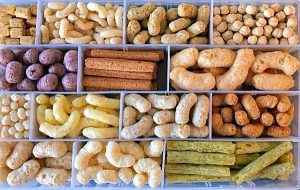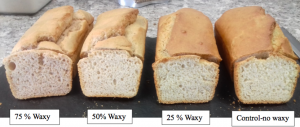PRODUCT SPOTLIGHT:
The next big snack is here…
 Consumers are looking for grain diversity, and sorghum can deliver. With expansion like corn and no GMO risk, Sorghum snacks are set to take off. After years of research, we have dialed in the unique spec and correct level of starch damage needed to run 100% sorghum through both twin and single screw extruders with expansion levels matching corn. All shapes and sizes are possible: from large puffs to small pellets. We can also customize texture and meltability for your specific product goals, such as baby & toddler puffs. And, sorghum plays nicely with others, adding expansion to veggie & legume extruded snacks. Increase value to your project’s bottom line with a high value, low-risk ingredient.
Consumers are looking for grain diversity, and sorghum can deliver. With expansion like corn and no GMO risk, Sorghum snacks are set to take off. After years of research, we have dialed in the unique spec and correct level of starch damage needed to run 100% sorghum through both twin and single screw extruders with expansion levels matching corn. All shapes and sizes are possible: from large puffs to small pellets. We can also customize texture and meltability for your specific product goals, such as baby & toddler puffs. And, sorghum plays nicely with others, adding expansion to veggie & legume extruded snacks. Increase value to your project’s bottom line with a high value, low-risk ingredient.
Contact us for an extrusion company recommendation.
FOOD TRENDS:
Customers Say They’re Willing To Pay More If It Has This:
Consumers are rewarding brands for transparency with increased loyalty and margins. A recent study found that nearly all consumers (94%) are likely to be loyal to a brand that offers complete transparency, and almost three in four consumers (73%) say they would be willing to pay more for a product that offers complete transparency in all attributes.
Clients have found vertical integration to be one of the biggest values Nu Life Market provides. Vertical integration allows full traceability of where each lot of sorghum is grown, resulting in meaningful information that can be passed on to the consumer, increasing brand loyally and the bottom line.
Why Sorghum Is Hot?
 The hottest ingredient in food has been US grown for hundreds of years. But why is it popping up now? Sorghum naturally meets several of the top food trends, ancient grain, non gmo, gluten free, and as the most sustainable cereal grain, sorghum usage will continue to grow for years to come due to excellent drought resistance (more below). Combined with great tasting food grade varieties, sorghum has quickly become one of the top food trends (Mintel/NYTIMES). The Annual McCormick Flavor Forecast is predicting sorghum grain bowls for breakfast, or with grilled foods with exotic spices. Our IQF sorghum performs like an all day cooked Arborio risotto rice, but ready to eat in 5 mins. Plan for the future—develop with sorghum.
The hottest ingredient in food has been US grown for hundreds of years. But why is it popping up now? Sorghum naturally meets several of the top food trends, ancient grain, non gmo, gluten free, and as the most sustainable cereal grain, sorghum usage will continue to grow for years to come due to excellent drought resistance (more below). Combined with great tasting food grade varieties, sorghum has quickly become one of the top food trends (Mintel/NYTIMES). The Annual McCormick Flavor Forecast is predicting sorghum grain bowls for breakfast, or with grilled foods with exotic spices. Our IQF sorghum performs like an all day cooked Arborio risotto rice, but ready to eat in 5 mins. Plan for the future—develop with sorghum.
DEVELOPER TOOLBOX:
How to Boost Fiber Under New Labeling Rules:
Nu Life Market just received confirmation from the FDA that our sorghum bran (white & black sorghum) will count as dietary fiber under the new labeling requirements. Adding sorghum bran to a formula will increase the fiber level on the new nutrition facts panel. Looking for a replacement for Inulin? Look no further than sorghum bran.


The Best Ingredient You Haven’t Heard Of:
 When was the last time your gluten free products were consumed by people who didn’t need to eat Gluten Free but ate them because of the great taste? There are now many gluten-free products, but what’s available is made from white rice flour or starch, causes instant blood sugar spikes, taste like cardboard, and offers little nutrition.
When was the last time your gluten free products were consumed by people who didn’t need to eat Gluten Free but ate them because of the great taste? There are now many gluten-free products, but what’s available is made from white rice flour or starch, causes instant blood sugar spikes, taste like cardboard, and offers little nutrition.
The market is ripe for disruption by gluten free products that actually taste great. Waxy sorghum can make any Gluten Free product significantly better by binding water, opening cell structure, reducing moisture migration, and improving moisture retention. Customers are seeing the greatest benefit in products the next day or in freeze-thaw situations. Waxy sorghum is a natural Whole Grain solution that can be labeled ‘sorghum flour’ on the ingredient deck, adding a competitive barrier to your project.
SUSTAINABILITY:
Achieving Water Reduction Goals With Sorghum
 By 2030, just 13 years away, 40% of the population is projected to face absolute water shortfall. (General Mills) As more companies adopt sustainability policies, sorghum can play an important part in meeting these goals. While other crops require close to 12 inches of water to produce the first bushel, it only takes six inches of total water (soil, rainfall, and irrigation) to produce the first bushel of grain sorghum.
By 2030, just 13 years away, 40% of the population is projected to face absolute water shortfall. (General Mills) As more companies adopt sustainability policies, sorghum can play an important part in meeting these goals. While other crops require close to 12 inches of water to produce the first bushel, it only takes six inches of total water (soil, rainfall, and irrigation) to produce the first bushel of grain sorghum.
The USDA Economic Research Service has indicated 80 percent of the nation’s water is consumed by agriculture. Water sources, like the Ogallala Aquifer, are being depleted at a much faster rate than they are being replenished. Water availability is declining, resulting in reduced irrigation capacity and heightened risk for growers. Swapping out other grains for sorghum will make a necessary impact on the amount of water used by agriculture, and is a meaningful step towards water security.
FOOD SAFTEY – Are You At Risk?
April showers bring May flowers… and also sorghum planting season! Historically, sorghum has been grown in the U.S. as animal feed with other feed grade crops. It’s not uncommon for sorghum to be grown alongside wheat, corn, and soy, resulting in increased risk of contamination.
But Nu Life Market does things differently. Before planting, fields are carefully selected and scouted to make sure there isn’t volunteer corn or soy from previous crops. Equipment is cleaned before planting and between each variety to ensure the purest fields of each Identity Preserved sorghum grain. The Farm to Family safety program continues throughout the growing season and into harvest, storage, and processing to ensure the sorghum remains contamination free.
